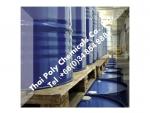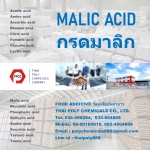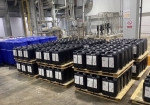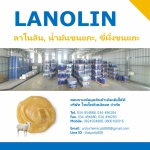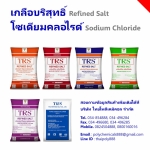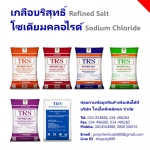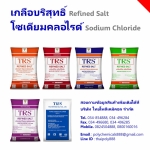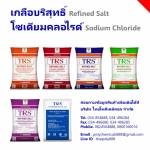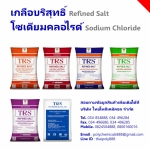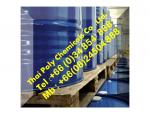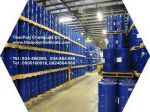โมโนเอทิลีนไกลคอล Monoethyleneglycol MEG EG |
฿1 |
|
ชื่อผู้ประกาศ : อัศวิน เบอร์โทรศัพท์ : 034854888, 034496284 โทรศัพท์มือถือ : 0800160016 ที่อยู่ : 36/5 ม.9 ต.นาดี อ.เมืองสมุทรสาคร ร้าน TPCC |
MONO ETHYLENE GLYCOL, MEG, โมโนเอทิลีนไกลคอล, โมโนเอทธิลีนไกลคอล
ETHYLENE GLYCOL, เอทิลีน ไกลคอล, เอทธิลีนไกลคอล
ประโยชน์/การใช้งาน
- ใช้เป็นตัวทำละลายสำหรับ cellulose ester และ ether โดยเฉพาะใน cellophane
- ใช้ในอุตสาหกรรมทำสีฉีดพลาสติก (emulsion paints) ผลิตเส้นใยโปลีเอสเทอร์
หมึกพิมพ์ กาวเครื่องหนัง ยาสูบ เครื่องสำอางบางชนิด
- ใช้เป็น coolant และ antifreeze
- เป็นส่วนประกอบใน brake fluids
- ใช้ในการเตรียม glycol diacatate
ETHYLENE GLYCOL นั้นมีจุดเดือดสูงกว่าน้ำถึงสองเท่าตัว(196
?C) ไม่มีสี ไม่มีกลิ่น ปัจจุบัน ETHYLENE GLYCOL ถูกทำให้จือจางลงใน ANTIFREEZE & COOLANT เพื่อให้เหมาะสมกับการใช้ในรถยนต์
โดยเฉพาะในรถยนต์ใหม่ ๆ ที่ออกมาจากโรงงานนั้น จะมีส่วนผสมของน้ำยานี้อยู่ถึง 50% นั่นหมายถึงถ้าหากว่าหม้อน้ำมีขนาดความจุประมาณ 5 ลิตรก็จะมีน้ำยาผสมมา 2.5 ลิตร องศาเลยทีเดียวอุตสาหกรรมส่วนใหญ่ที่ใช้ อาทิเช่น ใช้สำหรับอุตสาหกรรมสีและหมึกพิมพ์ อุตสาหกรรมน้ำมันเครื่อง
Ethylene glycol (IUPAC name:
ethane-1,2-diol) is an organic compound primarily used asa raw material in the manufacture of polyester fibers and fabric industry, and
polyethylene terephthalate resins (PET) used in bottling. A small percent is
also used in industrial applications like antifreeze formulations and other
industrial products. It is an odorless, colorless, syrupy, sweet-tasting
liquid. Ethylene glycol is only weakly toxic, but cases of poisonings are not
uncommon.EG is primarily used as a raw
material in the manufacture of polyester fibers and fabric industry, and
polyethylene terephthalate resins (PET) used in bottling. A small percent is also
used in other applications such antifreeze formulations and other products.Coolant and heat transfer
agent[edit]The major use of ethylene glycol
is as a medium for convective heat transfer in, for example, automobiles and
liquid cooled computers. Ethylene glycol is also commonly used in chilled water
air conditioning systems that place either the chiller or air handlers outside,
or systems that must cool below the freezing temperature of water. In
geothermal heating/cooling systems, ethylene glycol is the fluid that
transports heat through the use of a geothermal heat pump. The ethylene glycol
either gains energy from the source (lake, ocean, water well) or dissipates
heat to the source, depending if the system is being used for heating or
cooling.Pure ethylene glycol has a
specific heat capacity about one half that of water. So, while providing freeze
protection and an increased boiling point, ethylene glycol lowers the specific
heat capacity of water mixtures relative to pure water. A 50/50 mix by mass has a specific heat capacity of about 3140 J/kg C (0.75 BTU/lb F) three quarters that of pure water,thus requiring increased flow rates in same system comparisons with water.
Additionally, the increase in boiling point over pure water inhibits nucleate
boiling on heat transfer surfaces thus reducing heat transfer efficiency in
some cases, such as gasoline engine cylinder walls. Therefore, pure ethylene
glycol should not be used as an engine coolant in most cases.Antifreeze[edit]
Ethylene glycol disrupts hydrogen
bonding when dissolved in water. Pure ethylene glycol freezes at about ?12 ?C (10.4 ?F), but when mixed with water, themixture does not readily crystallize, and therefore the freezing point of the
mixture is depressed. Specifically, a mixture of 60% ethylene glycol and 40% water freezes at ?45 ?C (?49 ?F). Diethylene glycol behaves similarly. It is used as a de-icingfluid for windshields and aircraft. The antifreeze capabilities of ethylene
glycol have made it a component of vitrification (anticrystallization) mixtures
for low-temperature preservation of biological tissues and organs.Ethylene glycol freezing point vs.
concentration in waterWeight percent EG (%) Freezing point (?F) Freezing point (?C)
0 32 0
10 25 ?4
20 20 ?7
30 5 ?15
40 ?10 ?23
50 ?30 ?34
60 ?55 ?48
70 ?60 ?51
80 ?50 ?45
90 ?20 ?29
100 10 ?12
However, the boiling point for
aqueous ethylene glycol increases monotonically with increasing ethylene glycol
percentage. Thus, the use of ethylene glycol not only depresses the freezing
point, but also elevates the boiling point such that the operating range for
the heat transfer fluid is broadened on both ends of the temperature scale. The
increase in boiling temperature is due to pure ethylene glycol having a much
higher boiling point and lower vapor pressure than pure water; there is no chemical
stabilization against boiling of the liquid phase at intermediate compositions,
as there is against freezing.Ethylene glycol boiling point vs.
concentration in waterWeight Percent EG (%) Boiling Point (?F) Boiling Point (?C)
0 212 100
10 215 102
20 215 102
30 220 104
40 220 104
50 225 107
60 230 110
70 240 116
80 255 124
90 285 140
100 387 197
Monoethylene Glycol
Monoethylene glycol (MEG) is animportant raw material for industrial applications. A primary use of MEG is in
the manufacture of polyester (PET) resins, films and fibers. In addition, MEG
is important in the production of antifreezes, coolants, aircraft anti-icer and
deicers and solvents.
Applications for Monoethylene
Glycol, Ethylene Glycol:Polyester Resins
Antifreeze and Coolants
Gas Dehydration and Treating
Chemical Intermediates
Heat Transfer Fluids
Solvents
Other Applications
Polyester Resins
Ethylene glycols are used as a
reactant in the manufacture of polyester resins. Dow produces ethylene glycols
for use in polyester fiber, films and polyethylene terephthalate (PET) resin
production, as well as alkyd resins used in paints. The uses for polyester
resins are extremely varied, and include boat and marine, construction
materials, automotive and aircraft bodies, luggage, furnishings, appliances,
textiles and packaging.Polyester fibers are commonly found in textile
applications including clothing and carpets.Polyester films are frequently used
in packaging and wraps for consumer goods, as well as video, audio and computer
tapes. PET is widely used in the manufacturing of beverage bottles and
containers, and other consumer goods packaging.Antifreeze and Coolants
Ethylene glycols remain viscous at
low temperatures; they have a low freezing point and high boiling point.
Ethylene glycols are frequently used to make automobile antifreeze and
coolants, aircraft anti-icing and deicing materials.Gas Dehydration & Treating
Ethylene glycols are commonly used
in natural gas hydration and treating applications to remove water and
impurities. Diethylene glycol (DEG), Triethylene glycol (TEG) and Tetraethylene
glycol (TETRA EG) have excellent hygroscopicity and low volatility. Because of
these characteristics, DEG, TEG and TETRA EG are in high demand in the natural
gas drying market.Chemical Intermediates
Ethylene glycols including
monoethylene glycol (MEG), diethylene glycol (DEG), triethylene glycol (TEG)
and tetraethylene glycol (TETRA EG), are versatile chemical intermediates used
to produce a variety of products for commercial and industrial use:Adhesives and coatings
Emulsifiers
Lubricants
Plasticizers
Polyurethane foams
Solvents
Silicone compounds
Thermoplastics
Unsaturated polyester resins
Heat Transfer Fluids
Monoethylene glycol (MEG),
diethleyene glycol (DEG), triethylene glycol (TEG) and tetraethylene glycol
(TETRA EG), due to their low freezing point, freezing point depressant and high
boiling point are predominantly used in heat transfer fluids.Solvents
Diethylene glycol (DEG),
triethylene glycol (TEG) and tetraethylene glycol (TETRA EG) have excellent
solvent properties. TEG and TETRA EG are used as solvents in several
applications:Aromatic and paraffinic
hydrocarbons separationsCleaning compounds
Cyanoacrylate and
polyacrylonitrilePolyethylene terephthalate (PET)
production equipment cleaningSteam-set printing inks
Other Applications
Triethylene glycol (TEG) and
tetraethylene glycol (TETRA EG) may be used directly as a plasticizer or
modified by esterification. As a plasticizer, TEG and TETRA EG are used in the
manufacture of:Safety glass
Separation membranes (silicone
rubber, polyvinyl acetate, cellulose triacetate)Ceramic materials (resistant
refractory plastics, molded ceramics)Demand for tetraethylene glycol is
strong in the area of BTX (benzene, toluene, xylene) extraction to separate
aromatic hydrocarbons from non-aromatic hydrocarbons.Monoethylene glycol (MEG),
diethylene glycol (DEG) are often used in water-based paints, dry-wall
compounds, glass cleaners, dyes, waxes and adhesives as a freezing point
depressor to avoid damage by low-temperature extremes.In addition, monethylene glycol
and diethylene glycol are also used as binders for foundry sand molding, and a
lubricant for glass- and cement-grinding. In addition, both homologs are also
used as humectants in textile fiber, paper, leather, adhesive and glue
applications.
สอบถามข้อมูลเพิ่มเติมได้ที่
ฝ่ายขายThai Poly Chemicals Co., Ltd.
บริษัท ไทยโพลีเคมิคอล จำกัด
ที่อยู่36/5 ม.9 แขวง/ตำบลนาดี เขต/อำเภอเมืองสมุทรสาคร จังหวัดสมุทรสาคร รหัสไปรษณีย์74000
Tel.: 034854888,
034496284
Fax.: 034854899,
034496285
Mobile: 0824504888,
0800160016
Website : www.thaipolychemicals.com
Email1 : thaipolychemicals@hotmail.com
Email2 : info@thaipolychemicals.com
MEGโมโนเอทธิลีนไกลคอลเอทิลีนไกลคอลDEGเอทธิลีนไกลคอลethyleneglycolmonoethyleneglycolโมโนเอทิลีนไกลคอลเอ็มอีจี

